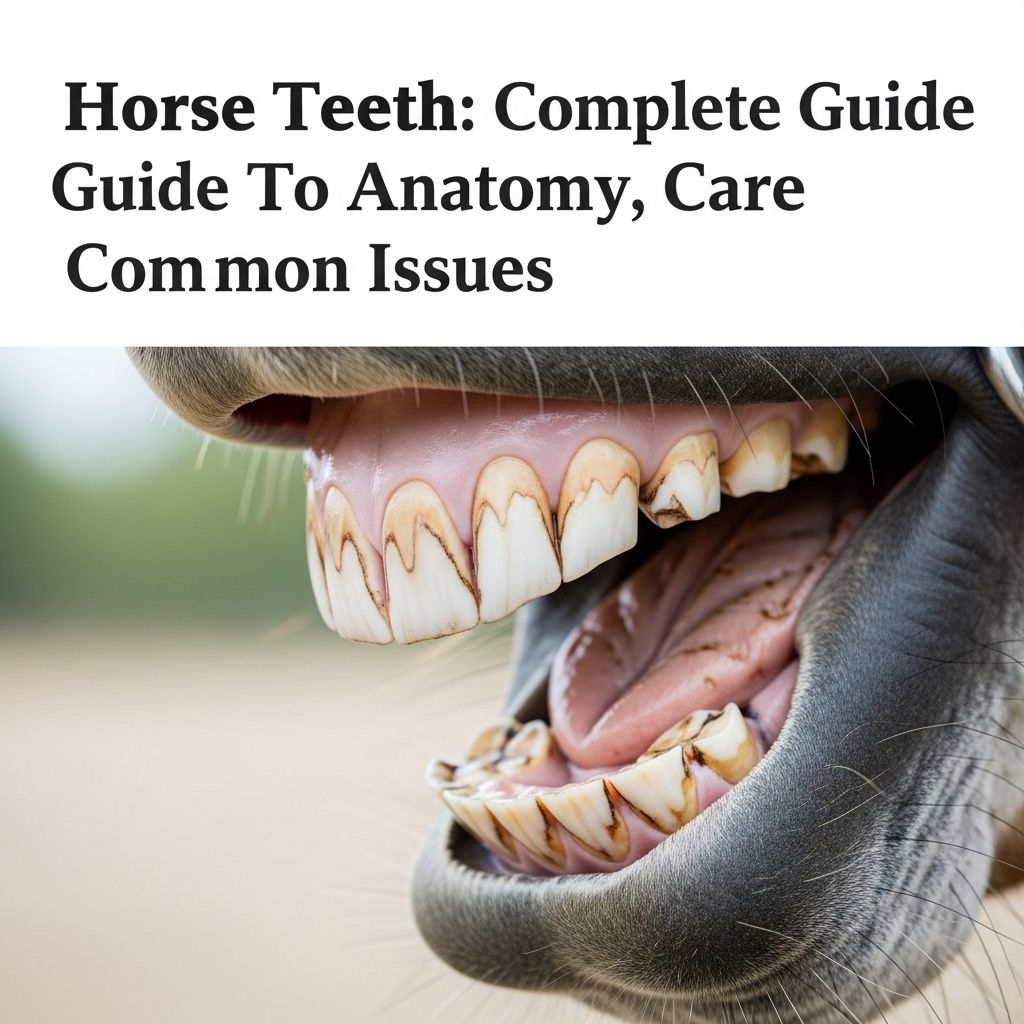Horse Teeth: Complete Guide To Anatomy, Care, And Common Issues
Regular exams ensure smooth grazing and lasting comfort for your equine partner.

Understanding Horse Teeth: Anatomy, Function, and Care
The teeth of a horse play a pivotal role in health, nutrition, comfort, and overall well-being. Regular dental exams and awareness of common dental challenges are essential for every horse owner. This guide explores equine dental anatomy, the stages of dental development, prevalent issues, care strategies, and frequently asked questions, defining how proper dental management supports optimal horse health.
Dental Anatomy of Horses
Equine teeth are complex structures designed for efficient grazing and food processing. Understanding their anatomy is crucial to recognizing dental health needs and problems.
Layers of an Equine Tooth
- Pulp: The innermost layer, containing nerves, blood vessels, lymphatics, and odontoblasts. It is vital for nourishing the tooth and forming dentin.
Key function: Maintaining vitality and growth. - Dentin: A protective, living tissue surrounding the pulp, enabling restoration and resilience after wear.
Key function: Protects pulp and provides bulk. - Enamel: The hardest tissue of the tooth, forming ridges on the chewing surface, integral to grinding food.
Key function: Withstands wear but cannot regenerate when damaged. - Cementum: The outer layer, connects the tooth to the periodontal ligament, playing a supporting role during chewing.
Key function: Anchors tooth, similar to bone.
Periodontium and Tooth Support
- Holds tooth in the alveolus (socket)
- Includes the gum (gingiva), periodontal ligament, alveolar bone, and cementum
- Junctional epithelium creates a tight seal around the tooth
- Periodontal ligament attaches tooth to the socket, allowing flexibility and preventing breakage
| Layer | Main Role | Unique Features |
|---|---|---|
| Pulp | Vitality, growth | Nerves and blood supply present |
| Dentin | Protection | Can regenerate |
| Enamel | Chewing surface | Hardest, non-regenerative |
| Cementum | Attachment | Connects to ligament, similar to bone |
The Types of Horse Teeth and Their Functions
Horses possess several types of teeth, each fulfilling specific purposes related to grasping, cutting, and grinding forage.
Incisors
- 6 upper and 6 lower incisors
- Designed for grasping and cutting forage before chewing
- First set in foals emerges around 6 days, with new sets appearing at 6 weeks and 6 months
- Permanent adult incisors erupt at roughly 2.5, 3.5, and 4.5 years of age
Canines
- Prominent in male horses, rare in females
- Typically erupt between 4 and 5.5 years of age
- Located between incisors and first premolars
- Sometimes confused with wolf teeth
Wolf Teeth
- Small, vestigial teeth in front of first upper premolars
- Erupt at 6–18 months; may occur in upper or rarely lower jaw
- No current function, but may cause discomfort with the bit during riding
- Early removal is often recommended to avoid complications
Cheek Teeth (Premolars and Molars)
- Grind forage for digestion
- 12 premolars and 12 molars: three premolars and three molars per side, both jaws
- Deciduous premolars (caps) in foals, replaced by permanent teeth by age three
- Cheek teeth have folded enamel ridges for efficient grinding and slow wear
- Provide a rough occlusal surface for processing tough plant matter
Dental Development Stages in Horses
From birth to adulthood, horses undergo distinct stages of dental development, each requiring special attention.
Foal to Young Horse
- Deciduous (milk) teeth erupt in predictable patterns
- Three sets of incisors erupt within first six months
- Premolars present as ‘caps,’ which shed over time
- Cheek teeth erupt as molars and premolars develop
Permanent Teeth
- Adult teeth replace milk teeth, finishing by about 5 years old
- New teeth erupt behind the caps, which fall out naturally
- Mature horses have up to 40 teeth, depending on sex and individual development
How Horse Teeth Function During Feeding
Equine teeth are adapted to grazing and chewing tough, fibrous grasses, supporting their digestive system and energy needs.
- Incisors cut and grasp grass
- Canines are seldom used in females but may help separate forage in males
- Cheek teeth grind food with complex enamel ridges, crucial for breaking down cellulose
- Slow, side-to-side jaw motion optimizes grinding
Common Dental Problems in Horses
Ineffective or abnormal dental wear often leads to discomfort, poor digestion, and behavioral changes. Awareness and routine examination help identify and address issues promptly.
Sharp Enamel Points
- Cheek teeth can form sharp edges due to uneven wear
- May cause pain, ulcers, and difficulty in eating or accepting the bit
Malocclusions
- Includes overbites (‘parrot mouth’), underbites, and irregular tooth alignment
- Results in difficulty in cutting/grinding food, and uneven wear
Retained Deciduous Teeth (‘Caps’)
- Occur when milk premolars do not shed properly
- Cause discomfort, especially in young horses
- May require manual removal by a veterinarian
Wolf Teeth Complications
- Large, displaced, or mandibular wolf teeth may interfere with the bit
- Removal is usually performed before training with a bit to prevent sensitivity
Other Issues
- Tooth fractures, abscesses, and infections
- Periodontal disease, affecting gums and underlying bone
- Luxation (displacement) or ankylosis (fusion) of teeth in severe cases
Signs of Dental Trouble in Horses
Recognizing symptoms of dental problems allows for early intervention and prevention of more serious health concerns.
- Dropping food or ‘quidding’ (leaving partially chewed mounds of feed)
- Excessive salivation
- Difficulty eating or weight loss
- Head tossing, resistance to the bit
- Facial swelling, foul breath
The Importance of Routine Dental Care
Proactive dental care is crucial to sustaining health and comfort. Recommendations may vary with age, breed, and specific risk factors.
- Annual dental exams are generally recommended
- Floating (filing or rasping sharp enamel points) is a common procedure to maintain even wear
- Regular care helps identify problems before they cause major health or performance issues
- Early intervention and treatment limit the need for complex procedures
- Some horses may require more frequent checks, particularly those with a history of dental issues
Dental Procedures: What to Expect
Professional dental treatment is straightforward but essential for overall horse welfare.
- Dentists or veterinarians use speculums to assess all tooth surfaces
- Local anesthesia may be used for extractions or correction of severe malocclusions
- Wolf teeth and retained caps are typically removed at a young age if problematic
- Filing (floating) smooths sharp points and restores normal chewing action
Special Considerations for Different Age Groups
- Foals and Young Horses: Monitor teething bumps and caps; ensure teeth develop and erupt properly
- Adult Horses: Regular floating, monitor for emerging dental abnormalities
- Senior Horses: Frequent exams, as teeth may become loose, worn, or lost, affecting nutrition
Frequently Asked Questions (FAQs)
Q: How often should my horse have its teeth checked?
A: Most horses benefit from annual dental exams, but some may require more frequent evaluations, especially young or senior horses, or those with dental concerns.
Q: What are wolf teeth, and should they be removed?
A: Wolf teeth are small, vestigial teeth in front of the first upper premolars. Removal is recommended if they interfere with the bit or cause discomfort.
Q: What is ‘floating’ and why is it important?
A: Floating means filing sharp enamel points on cheek teeth to prevent pain, ulcers, and uneven chewing. It helps maintain lasting comfort and proper digestion.
Q: What signs indicate dental issues in horses?
A: Quidding, dropping food, excessive salivation, resistance to the bit, weight loss, and foul breath are common signs of dental problems.
Q: Can dental issues affect a horse’s behavior or performance?
A: Yes, dental pain or discomfort can lead to behavioral changes, inability to accept the bit, reluctance to eat, and reduced activity or willingness to work.
Summary Table: Horse Teeth by Type and Function
| Tooth Type | Location | Main Function | Age of Eruption |
|---|---|---|---|
| Incisors | Front, upper and lower jaw | Grasping, cutting forage | 6 days – 4.5 years |
| Canines | Gap between incisors and premolars | Minor, often vestigial | 4 – 5.5 years (usually males) |
| Wolf Teeth | In front of first premolars | None, may cause discomfort | 6 – 18 months |
| Premolars | Cheek (behind canines) | Grinding, chewing | Up to 3 years |
| Molars | Cheek (behind premolars) | Grinding, chewing | Up to adulthood |
Equine Dental Health: Fast Facts
- Horses can develop up to 40 teeth, including vestigial wolf teeth and permanent canines
- Dental wear and alignment must be regularly monitored to avoid discomfort
- Routine ‘floating’ supports lasting dental health and improves feeding efficiency
- Wolf teeth are often removed to prevent bit interference
- Senior horses require special attention due to tooth loss, wear, or age-related disease
Further Reading and Resources
- Consult a qualified equine veterinarian for individual dental assessments
- Annual oral exams and preventative care minimize complications
- Reference guides from veterinary associations provide detailed dental anatomy diagrams
References
- https://thehorse.com/19389/back-to-basics-dental-anatomy/
- https://www.bwequinevets.co.uk/article/16/Equine-Dentistry/
- https://www.isvma.org/wp-content/uploads/2020/10/AnatomyandOralExamination.pdf
- https://www.polltopastern.com/post/the-anatomy-of-the-equine-mouth-and-why-dental-health-is-important
- https://www.anatomy-of-the-equine.com/horse-dental-anatomy.html
Read full bio of Srija Burman












